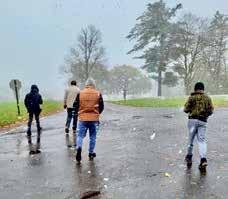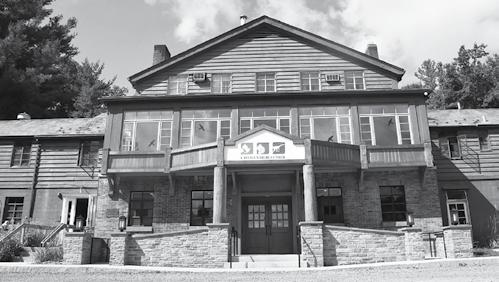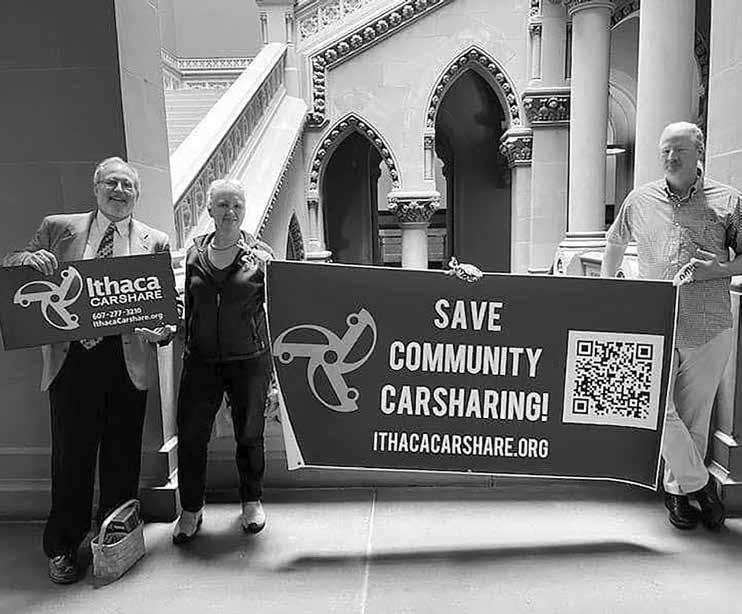On The Road Again

PAGES 8-9



PAGES 8-9

Last November, on a chilly, overcast day, the youth of The William George Agency for Children’s Services (WGA) donned their winter coats and braved the swirling snow flurries to embark on a campus loop, all for the benefit of neighboring families in need.
While remaining indoors might have been easier, these young individuals were committed to their cause. “Cultivating personal responsibility is a crucial step in one’s journey to maturity Many of the youth we work with have missed this step, to their detriment or to the detriment of others. We emphasize the importance of taking re s p o n s i b i l i t y a s a n i n t e g ra l p a rt o f t h e g ro w t h a n d h ea l i n g process,” explains Helen Hulings, the Executive Director of The W i l l i a m G e o r g e A g e n c y f o r C h i l d r e n ’ s S e r v i c e s , l o c a t e d i n Freeville, New York. The Agency specializes in providing out-ofhome behavioral, mental health, and addiction treatment services to children aged 12 to 18.
The teens at WGA eagerly participated in a Walk-A-Thon to raise funds for families enrolled in the Adopt-A-Family program of The Salvation Army Ithaca Corps. This event and a supplementary bake sale are an annual tradition at The William George Agency campus, where youth volunteer alongside Agency staff.
By the end of 2023, these youth had raised an impressive $3,167, benefiting six families—the highest amount ever raised and the most families assisted in a single year since the inception of the Walk-A-Thon a decade ago The funds were utilized to purchase gifts and groceries for families facing hardships during the holiday season.
“ The enthusiasm displayed by the children for this campusw i d e a c t i v i t y i s t r u l y h e a r t w a r m i n g , ” s a y s H u l i n g s . “ T h e y wholeheartedly engage, rallying support from staff, teachers, and others on campus. This activity fosters camaraderie and a sense of p u r p o s e a m o n g t h e y o u t h I t ’s i n s p i r i n g t o w i t n e s s t h e m demonstrate a sense of selflessness by engaging in an activity to serve others, which is part of the healing process. There’s even a friendly competition between residences to see who can raise the most money and recognition for best mascot, team spirit, and sportsmanship. The event concludes with hot chocolate and a b o n fi re b y o u r p o n d , f o s t e r i n g a s e n s e o f c e l e b r a t i o n a n d community.”
For families served by The Salvation Army, it ’ s a blessing.
“ The need is very real for our local families struggling to make ends meet, which is why we’re so grateful to receive continued support from the youth at The William George Agency. Since I’ve been here these past six years, I’ve seen the youth always be willing to do whatever they could to help. From the smallest thing to the biggest, from vacuuming a floor to volunteering as bell ringers to helping us distribute gifts and supplies. Unfortunately, I think there


will always be food insecurity in our community. A certain part of our population works so hard and still can’t make ends meet. Last year, we served a record number of families with children,” says Captain Stacy McNeil of The Salvation Army Ithaca Corps.
The Salvation Army Ithaca Corps is one of several nonprofits youth from The William George Agency have undertaken to support while in residence. Another is the Dryden Town Historical Society
“ Without their help, I hate to think about what we would have to do,” says Debbie Fisher, President of the Dryden Town Historical Society, which hosts an annual Opportunity sale in June and Homestead Heritage Fair in September Over the past several years, youth from WGA have helped with the set up and take down of such events; last year, the Opportunity sale brought in $8,000 for the small organization.
“ We have a lot of older volunteers, so it ’ s a huge help to have youthful strength around. The young men who have offered to help have always been responsive and responsible and seem to enjoy it as well.”
Other volunteer activities have included filling backpacks with food for the Weekend Backpack Program at the First Presbyterian Church of Dryden and placing American flags on the graves of v
American Legion Post 465. The former is a weekly commitment that youth sign up for during the school year and that benefits elementary school children. The latter has been a recurring event since 2017.
“Giving back is ingrained in our culture,” says Hulings. “ We believe the foundat ion of good citizenship includes helping others. Sometimes, it ’ s the act of helping another that can transform behavior and improve self-esteem and perspective.”
In a recent national study, the City of Ithaca has emerged as a focal point for “worker misery,” grappling with low wages, sluggish job growth, and alarmingly high-income inequality. The Milken Institute's findings reveal a perfect storm impacting the local workforce, prompting calls for immediate action from the Tompkins County Workers Center.
Pete Meyers, Coordinator of the Tompkins County Workers’ Center, expressed deep concern over the distressing figures presented in the study. Meyers emphasized the critical need for county action to establish a living wage as the minimum wage, stating, “County action to make the living wage ($18.45) a minimum wage is so needed now; it would go a long way to ameliorate worker suffering.”
The study assessed thirteen economic and social indicators and positioned Ithaca in the bottom fifth of all small metropolitan areas. One of the glaring issues highlighted was the city's dismal performance in wage growth between 2017 and 2022, where Ithaca ranked 188th out of 203 small U.S. metro areas. Job growth also languished, further compounding the challenges faced by the local workforce.
Perhaps the most alarming revelation was the extent of income inequality in
Ithaca. The city’s income inequality, measured by the Gini index at 49%, surpassed the U.S. average of 40%. According to the report, Ithaca’s income inequality is similar to countries like Angola (51%), Honduras (48%), Guatemala (48%), Jamaica (46%), and close to the New York City metro area (54%).

Ian Greer, Cornell Research Professor and Director of the Ithaca Co-Lab, emphasized the global significance of this disparity, stating, “For me, the takeaway is that Ithaca ranks very low in this report because of below-average wage growth and above-average inequality.” Greer added, “In global terms, the level of income inequality around here is staggering.”
Greer highlighted that below-average wage growth and above-average inequality were the primary factors contributing to Ithaca’s low ranking in the report.
Shaienne Osterreich, Professor and Chair of the Economics Department at Ithaca College, echoed these concerns, emphasizing the real-world consequences for residents. Osterreich noted, “In every conversation I have about Ithaca, people
ITHACA, NY — Local residents are invited to learn practical advice for how to successfully raise chickens for home egg production during “Keeping Backyard Chickens,” taught by Sarah Lubold. The class will take place at 5:30 p.m., Tuesday, March 5, at the Cornell Cooperative Extension (CCE) Tompkins County, 615 Willow Ave, Ithaca, NY 14850.
This class will explore topics including sourcing healthy birds, determining which laying varieties are best for your needs, options for housing and nutrition, common illness and pest prevention and the joys of living with chickens.
Residents in the Villages of Trumansburg and Dryden who wish to keep chickens need a permit and evidence that you have attended a class on raising chickens. This class meets that requirement, and attendees will receive a letter to take to their municipality upon course completion. Attendees from out-of-county should check with their local government to see if this class will meet education requirements in your area.
Course instructor Sarah Lubold is an ESOL educator, homesteader, amateur beekeeper, floral designer, folk artist and CCE Tompkins Master Gardener. She and her family live
are always talking about the affordable housing crisis.” The report revealed that 30% of Ithaca residents are paying more than 30% of their income on housing, a situation deemed unsustainable.
Osterreich connected the housing crisis to broader inequities, stating, “This report notes that 30% of Ithaca residents are paying more than 30% of their income on housing. This is unsustainable, and it maps onto multiple known inequities regarding housing, racialized and class-based labor market inequities, and meager inflationadjusted wage growth.” The dire circumstances are forcing families to contemplate leaving the town, highlighting the urgency of addressing these issues to ensure the
Continued on Page 7
Steve Lawrence, Marjorie Olds, Henry Stark, and Arthur Whitman
THE ENTIRE CONTENTS OF THE ITHACA TIMES ARE
COPYRIGHT © 2023, BY NEWSKI INC.
with a small flock of Rhode Island Reds and Khaki Campbell ducks in West Groton. When she is not working at Business is Blooming Floral Design Studio, Sarah is active in the Cayuga and Tompkins Counties’ farmworker and immigrant community or is spending time with friends and family in New York and her home state of Vermont.
Registration is $20 per household, but those interested in attending are encouraged to pay what they’re able. Details and a link to sign up are available at CCETompkins.org. Contact Marissa Nolan, Horticulture Team Lead, atmn623@cornell.edu with any questions.
All rights reserved. Events are listed free of charge in TimesTable. All copy must be received by Friday at noon. The Ithaca Times is available free of charge from various locations around Ithaca. Additional copies may be purchased from the Ithaca Times offices for $1. SUBSCRIPTIONS: $89 one year. Include check or money order and mail to the Ithaca Times, PO Box 27, Ithaca, NY 14851. ADVERTISING: Deadlines are Monday 5 p.m. for display, Tuesday at noon for classified. Advertisers should check their ad on publication. The Ithaca Times will not be liable for failure to publish an ad, for typographical error, or errors in publication except to the extent of the cost of the space in which the actual error appeared in the first insertion. The publisher reserves the right to refuse advertising for any reason and to alter advertising copy or graphics deemed unacceptable for publication. The Ithaca Times is published weekly Wednesday mornings.





In an ongoing move to address the multifaceted impacts of the COVID-19 pandemic, Tompkins County has announced the 2023 recipients of $6.53 million in Community Recovery Funds received through the American Rescue Plan Act (ARP).
The ARP allocated $19.8 million to Tompkins County, which has been instrumental in supporting a variety of initiatives aimed at revitalizing local businesses, nonprofits, and essential community services. Roughly 33% of funds went towards the Community Recovery Fund, with the remaining 67% going directly to operating and capital expenses.
Legislator Dan Klein, Chair of the Community Recovery Fund Advisory Committee, acknowledged the challenges of allocating funds, stating, “Creating a program from scratch was a big job. It turns out it’s harder to give away money than it seems.” The county sought to prioritize local businesses and not-for-profits, aiming to make a lasting impact on the community.
The Community Recovery Fund was designed to address the collective trauma experienced during the pandemic. In 2023, local organizations submitted 211 applications totaling more than $32 million in funding, but the county could only approve funding for 64 applications, totaling $6.53 million in spending.
The funding was allocated as follows:
1� Health and Housing Services:
• Ithaca Neighborhood Housing Services (INHS): Received $57,500 to offset operating costs incurred when forgiving
rent for tenants unable to access financial assistance between 2020 and 2022.
• Lifelong: Secured $17,000 to cover payroll expenses, retain jobs, and ensure full staffing, particularly for services to Tompkins County elders.
2� Diversity, Equity, Inclusion, and Justice:

• Khuba International: Granted $24,958 to support socially disadvantaged farmers and farming families, building equity into local food, land, housing, business, and education systems.
• CTA Gayogoho: no? Learning Project: Received funding to hire a part-time project manager ($74,086) to support using Gayogohó:no language resources and related technologies.
3 Long-Term Capacity Building:
• NAMI Finger Lakes: Granted $29,600 to cover operating costs, including salaries and rent, to expand in-person mental health programming and services.
• GIAC (Greater Ithaca Activities Center): Received $500,000 to support its Teen and Recreation Center project, culminating in renovating a new accessible gymnasium facility.
4� Supporting Not-for-Profits and Small Businesses:
• Brookton’s Market: Granted $10,000 to cover operating costs for rent, personal protective equipment, and some construction costs to help mitigate the spread of COVID-19.

• No Mas Lagrimas: Received $40,000 to scale up and increase their ability to provide hot meals, addressing critical community needs marginalized populations face.
5� Addressing Critical Gaps in Local Services:
• Habitat for Humanity: Utilizing $200,000 to construct
three affordable homes in Tompkins County.
• Tompkins Cortland Community College (TC3): Offering scholarships for micro-credential programs totaling $111,820, supporting specific, in-demand skills development.
6 Transformative Outcomes:
• Sustainable Finger Lakes: Retrofitted mobile homes owned by low to moderate-income residents with heat pumps, insulation, and electrical upgrades totaling $532,127, electrifying homes and increasing energy efficiency.
• Continuum of Care: $174,167 was allocated to support improvements in local homeless response services, including coordination and direct support for 40 chronically homeless individuals.
A complete list of organizations that received funding through the Community Recovery Fund can be found here.
Community leaders, including Klein, expressed the significance of these projects in fostering collective recovery. Klein highlighted the legislature’s approach, stating, “Giving all legislators equal weight in the allocation process was best as it drew upon our collective understanding of the needs of Tompkins County.”
Tiffany Bloss, Executive Director of Suicide Prevention & Crisis Service, emphasized the impact of the $50,000 grant received to cover expansion costs, allowing for increased services and operational hours. “We’re able to bring on more staff and are fortunate to operate 24/7 now,” Bloss remarked.
Executive Director of Coddington
The Cayuga Nature Center has received a transformative donation that will help fund the operations of its struggling native small animal program. The donation from The Lilac Foundation comes as the Nature Center is grappling with financial challenges that have resulted in shutting down several programs.
The Lilac Foundation’s contribution addresses the financial challenges faced by the Cayuga Nature Center, which had jeopardized the viability of its live animal program. In January, the Paleontological Research Institution (PRI) — which owns the Nature Center — announced that it would be ending its live animal program and rehoming its animals due to continued financial challenges.
Fortunately, this donation will help secure the continued existence of parts of the program.
The Nature Center has already begun to rehome several of its animals, but the organization still needs to rehome about 60% of their “animal ambassadors. A list of animals that have already been rehomed can be found on the Nature Center’s website.
age regarding the downsizing plan helped raise awareness about the financial struggles being experienced at the Nature Center. She said that coverage “helped get the word out, and in return a foundation we’ve never received support from before reached out and wanted to help save the program if they could.”
The donation will secure the future of the small native animal program at the Nature Center. This program includes native reptiles, amphibians, and invertebrates and will now continue to bring handson environmental education experiences to the community.

The donation will not save the entirety of the live animal program, and the Nature Center still needs to regime 60% of their “animal ambassadors”. (Photo: File)

Ups
Tompkins County Legislature Chair
Dan Klien has said that the County is contemplating introducing a Countywide living wage as the minimum wage, after guaranteeing that all County employees would receive a living wage. Klien says discussions are in the “infancy stage.”

Downs
Ithaca police are conducting an investigation into a recent shooting that occured around midnight on Feb. 21st at the Arthaus apartment complex in Ithaca’s West End. No injuries were reported from this incident.
Schmitt Phia said, “The small native animal program being preserved is a subset of the previous animal program, which we were ending due to the downsizing plan.”
“The small native animal program being preserved is a subset of the previous animal program, which we were ending due to the downsizing plan.”
— Amanda Schmitt Piha
Amanda Schmitt Piha, Associate Director for Philanthropy and Communications at PRI, expressed her gratitude, stating, “We are deeply grateful for the Lilac Foundation’s commitment to our animal program and the impact this donation will have on the Cayuga Nature Center.”
According to Schmitt Phia, press cover-
Despite the significance of this donation, it cannot sustain the entirety of the live animal program, which previously included more than 70 animals.
However, the Nature Center will now be able to preserve a small portion of its native animal ambassadors. This selected collection will play an essential role in ongoing education programs, ensuring the continuation of public programs, birthday parties, and paid group programs.
Schmitt Phia said that the total cost of the entire live animal program was more than $200,000 per year, and the donation will help cover $90,000 of the scaled-down program. “After conversations with staff, we were able to develop a strategy that would allow us to keep a smaller number of our native live animals that can be used to continue education programs while being fiscally responsible and maximizing the impact of the gift,” Schmitt Phia said.

She continued saying the donation would cover the cost of running the native small animal program for two years. Schmitt
Phia added, “In that time, we will build a more sustainable financial strategy, especially for the program, through fundraising and philanthropy.”
“This support is an important step towards continuing our efforts in animal and environmental education, making a lasting difference in the lives of both the animals and the community we serve,” emphasized Schmitt Piha. The Lilac Foundation’s generosity provides a lifeline for the Nature Center to persist in promoting awareness, appreciation, and understanding of the local ecosystem. Furthermore, it emphasizes the importance of respecting wildlife and their habitats.
As the Nature Center expresses its sincere gratitude to the Lilac Foundation, it also calls upon the community for continued support. Schmitt Piha emphasized, “We will need the support of our community to help maintain the resources needed to keep this program strong for future generations.”
According to Schmitt Phia, “the future size of the live animal program will be completely dependent on funding received to support the program specifically, but, likely, it may never be as large as it was before.” She continued, “The goal moving forward is to preserve this core program of the Cayuga Nature Center and offer the unique educational experiences to the community that these live animal ambassadors can provide while being fiscally responsible. It is important not to grow the program beyond what we can handle; our priority remains providing these animals with the highest level of care.”
For those inspired to contribute to the cause, donations to support the Cayuga Nature Center and the animal program can be made at www.cayuganaturecenter.org/ donate. The platform offers an accessible and transparent way for individuals to contribute to the Nature Center's ongoing initiatives.

Heard
Tompkins County 911 Center in Ithaca, NY, has recently been acknowledged by the National Center for Missing & Exploited Children (NCMEC) for its commitment to the safety of children.

Seen
Ithaca police have launched an investigation into a potential overdose death that occured on February 25 on the 700 Block of Cliff Street.
IF YOU CARE TO RESPOND to something in this column, or suggest your own praise or blame, write news@ithacatimes. com, with a subject head “U&D.”
Are you excited to stuff your face with Chili at this year’s Chili Cook-Off on March 2nd?
22 5 % Yes, bring on the chili.
15 . 0 % No, I prefer the Mac & Cheese Bowl
62 . 5 % I don’t care.

you think Tompkins County should make the County minimum wage equal to the living wage?
“I am very sad to learn of the conditions at the SPCA of Ithaca. When my mother passed away in 2012 learned at that time that she had regularly donated to the SPCA. Since her passing I continued that tradition to this day. I have to say after reading this article my donations will be on pause pending the outcome of the independent investigation. I was of the belief, obviously incorrectly so, that this was a no kill shelter. I advocate 100% for the animals and expect everything humanly possible to be done to save the animal with the best possible supervision and care and input from all persons involved. Volunteers are on the front line and their comments and opinions should carry much weight and have a place at the table when discussions are had about the welfare of the animals. Their opinions should not be dismissed, in fact just the opposit. I usually do not comment regarding various topics but I feel very stringly about this is-
sue and I look forward to the changes and direction of the SPCA in Ithaca to be in the ANIMAL’S BEST INTEREST. Unfortunately it seems from what I read we have lost focus, direction, lack of a business plan and future growth.” — William Post
“As a former worker (fake name) I do not appreciate the comments on Emme. She is fully trained, keeps up on education, and works as best she can. The issue being there can be dozens of dogs and there’s only one of her and her ‘assistant’ who has been doing animal behavior work for decades. When I started in ‘14, we had 2 full time and 1 part time, but it was cut due to budget constraints. My main concern working there was the Director’s pay, which of two to three years ago 30k higher than the national average for his position.
I do feel the people working with the animals were often under heard, but we also had struggles with volunteers not following protocols for their safety, and the animals, including dietary needs. I am absolutely sure it was not all of them, however, it was enough to cause problems.” —
Moyra Sinclari“Finally! I’ve been waiting for this article for years! Is it the best? No, but when you depend on anonymous sources who are afraid to speak out (it is the animals who will suffer if they do), this article is the best that can be expected. I really

hope the TCSPCA board does a full investigation into these serious allegations. But since the board is stacked with Jim’s friends, I have my doubts. One can hope. Thanks to the Ithaca Times for putting its neck out on this, and for the brave volunteers and staff for stepping up.” —
Bentley Dubois“I found it unfortunate that this article denigrated two of the most committed shelter employees at our SPCA. As a volunteer with the dogs, I have received ongoing training, instruction, and the tireless attention of the behavior personnel. I see how the pups respond to them, as if they were dog whisperer’s. They balance daily the needs of the dogs, with the safety of the volunteers and potential adopter’s. I see in them patience, commitment, and love.
Both Enzo and Bill are very much alive. There must have been some miscommunication here.” — Tish keen
“Can confirm that Bill and Enzo were set to be euthanized after minor bite incidents. They weren’t deemed aggressive, but rather ‘potential liabilities’ for the shelter. The standard for behavior-based euthanasia in most no-kill shelters is aggression with low chances for rehabilitation. Killing them because they were potential liabilities was a choice made by the director. They were adopted by people associated with the shelter in order to save them from being killed (which would be puzzling if they were indeed aggressive). They’re not the only dogs that have found themselves in that situation. They just got lucky and lived.” — GOB Bluth
“I’ve seen the letter that was sent to the dog volunteers about Bill, and I would hardly characterize the problem as a ‘minor bite incident’. It also provided a very detailed explanation of the incident and what/why it indicated a problem serious enough to warrant such a drastic solution. The fact that he and Enzo were adopted by SPCA insiders doesn’t necessarily indicate that the problems weren’t serious, just that they were people uniquely qualified to provide them homes because of their knowledge and training, and cared enough to do it.” —
Paula Amols“A volunteer saw what happened during Bill’s incident. It wasn’t anything like the staff member indicated. As far as I’m aware he hasn’t shown any type of behavior noted in that email that was sent out to volunteers about him. Why wasn’t there more done with him? Can you agree that the SPCA did not do all they could for Enzo and Bill, and many other dogs you have no idea about? I want to see them do
as much for the dogs as they seem to do for the cats at that shelter.” — Bob Amon
“We are disappointed and appalled that the Ithaca Times would publish such a one sided and unsubstantiated story as the one about the SPCA. Giving such credence to claims and complaints from a few clearly disgruntled staff and volunteers, without any apparent effort to speak with others who would tell a much different story or to verify the claims, is just shoddy journalism.
> We have been volunteers at the SPCA collectively for many years, and have seen and experienced nothing even remotely resembling what is described in the article, quite the opposite in fact.
> The staff is dedicated to providing the best possible care and outcome for all the animals it takes in. We know the great lengths that the SPCA goes to in order to treat and save animals that other no-kill shelters would deem unadoptable, and euthanize. And on those few occasions when an animal’s future is in doubt, whether for behavioral or medical reasons, there has been complete transparency in communicating with the volunteers, detailing the efforts being made to avoid what is only a last resort.
> And the SPCA most certainly supports the needs of pet owners in the local area. They do this in many ways, including their weekly low-cost spay and neuter clinics, rabies clinics, and a food pantry for pet owners who need assistance in providing their pets with food and supplies. There are also cases when they have given temporary shelter to pets whose owners have found themselves unexpectedly homeless or in a situation where they cannot care for their pets for a short period of time. Transport animals—those coming from high-kill shelters elsewhere in the country—are only brought in when there is available space at the SPCA, and never at the expense of local animals in need.
> All of that takes money, and the director and his staff have done a stellar job in raising those funds, and it is the result of more than just a few events, it is an ongoing effort all year.
> We question the true motives of those who felt it necessary to air their grievances so publicly, rather than address them directly to the SPCA’s Board of Directors, it makes the veracity of their claims even more suspect. If they truly cared about the animals, they wouldn’t do something that can potentially hurt the SPCA’s mission and efforts on behalf of animals in need.” —
Paula Amols (7 yearPrimary season is upon us, this year a slow-motion study in foregone conclusions. The major party candidates’ ages have long been a topic of discussion, and particularly the vintage of President Biden. Recently, the report of the special counsel exonerating the president of wrongdoing in mishandling classified documents was released, and it’s piled more fuel on that particular fire. The POTUS was described as a person who would likely come across to a jury as a “well-meaning elderly man with a poor memory”. Being 81 years old, as Biden is, is not necessarily a disqualifying quality for the most stressful, consequential, and demanding job in the world. Not only is that ageist thinking, it’s been suggested that the president is one of a growing number of ‘super-agers’. Our research department has located three local 81-yearolds with high octane jobs, all of whom, by bizarre coincidence, are also named “Biden”, and they’re performing at the top of their games. Let’s visit…
Ladies and gentlemen, good afternoon. This is Captain Biden speaking. I know you have a lot of choices when choosing carriers and thank you for choosing Pan American Airlines. We are presently cruising at 39,000 feet on our flight from Atlanta to London, and we’re expecting a smooth…wait…I’m being informed that we haven’t taken off yet. Also, we’re in Ithaca, not Chicago. What? I said ‘Atlanta’? Are you sure? Gosh. Well anyway, the cabin crew will be coming around to offer you a light snack and beverage. We do ask that passengers not in the smoking section refrain from… [announcement abruptly ends]
Is this room R-202? Finally! This place is like a maze. Good morning, I’m Doc-
continued from page 3
sustainability of the community.
The 2023 Ithaca Living Wage Report offered a comprehensive overview of the city's economic challenges and is a crucial resource for policymakers and community leaders. The report announced that the new living wage for Tompkins County is $18.45 per hour, an increase of nearly $2

tor Biden, and I wanted to come by and introduce myself. I’ll be performing your tonsillectomy today. Now, I’ve done this procedure hundreds of…a coronary bypass? Of course. I totally knew that. I’ve done those before, too. Naturally, it’s been a while. I think Helmut Kohl was president. So, I just want to reassure you that you have nothing to worry about. Just relax. I’m the most experienced surgeon at Rochester General… oh, check, Cayuga Medical Center…and this a routine procedure. Now, if someone could just point me in the direction of the operating room…
Hi, students, I’m Mrs. Biden and I’ll be subbing for your teacher Mrs. Augustine all this week. My, my, this does bring back memories. I used to teach this same class, Civics, right here in Utica when I first started out. What? Ithaca? My stars. Well, no matter. Here — I’ve brought one of my favorite lesson plans. This week, we’ll be comparing our system of government with that of the Soviet Union. I need a volunteer to go to the library for an overhead projector. All right, you six may go. And no stopping by the smoking lounge! Maybe we should start with attendance. Now where does she keep her grade book? Land sakes.
RELATED NOTE: I know commercial airline pilots have a mandatory retirement age. I myself would have been eased into retirement years ago.
UNRELATED NOTE: If you’re interested in seeing an excellent re-creation diorama of what the West End of Ithaca looked like 70 years ago, visit the Chemung Canal Bank at the old Lehigh Valley Station (806 West Buffalo Street). If you go any Friday afternoon this month from 2-4 p.m. you can visit with the diorama’s creator, David Fogel.
from last year's living wage of $16.61. According to the study, the most critical factor driving the increase in the living wage is the increased cost of housing.
The report estimates that roughly 18,000 workers living in Tompkins County earn less than the living wage. The study states, “The likelihood of earning a living wage in Tompkins County is systematically linked to a worker’s race-ethnicity
Continued on Page 14
Dear SPCA family, I am writing to you today to address the recent article in our local paper that alleges “mismanagement” at the SPCA.
First, I would like to say that I have been at the SPCA for almost 13 years. It has been a pleasure and an honor to serve the animals of Tompkins County, our supporters, and countless volunteers who all help make our work possible.
More than that, it has been a privilege to work alongside some of the most dedicated, caring, and hard-working coworkers I have ever had. Over one third of our approximately 35 staff members have been with the SPCA for 10 years or more.
Our medical staff and veterinarians are among the best in the region. Our medical department manager has been with the SPCA for 19 years. We have been working closely with the same veterinary service since 2010. This team includes veterinarians who are board-certified specialists in shelter medicine and recently edited/coauthored the Association of Shelter Veterinarians’ 2022 Guidelines for Standards of Care in Animal Shelters, as well as a veterinarian board-certified in preventive medicine with a special interest in animal behavior.
These people form the backbone of the SPCA and are fundamental to fulfilling our mission as the first open admission “no-kill” shelter in the United States. I am continually amazed at what we can achieve together despite the very real and very difficult cases we deal with day in, and day out at the SPCA.
I think sometimes what might prompt a “complaint” stems from a misconception of how we operate, how we make decisions, and what that process entails.
When I was asked to provide comments on the allegations received, I provided the reporter with a copy of our Euthanasia Policy. That policy is located further along in this newsletter. We think it is important that our community understands what “no-kill” actually means and that we as an organization are transparent about it. For some, it means that animals are never euthanized, but that is not the case. Unfortunately, as much as all of us here would like to see every single animal leave our shelter with a positive outcome, that is not the reality.
Like our own pets, many animals have medical conditions that just cannot be treated or managed. A small number of others have a history of aggressive or dangerous behavior or have exhibited behavior while in our care that is dangerous or aggressive. In most cases, that includes a serious bite to a person. We have a duty to ensure that the animals adopted do not pose a danger to our community.
Unfortunately, there are times when we must make the difficult decision to cease working with an animal that poses a risk to our staff, volunteers, and members of our community.
Simply put, the decision to euthanize an animal for behavioral issues is incredibly hard to make and can have an emotional impact on our staff and volunteers-the people who may have been caring for the animal for weeks or months. However difficult the decision is, the SPCA also has a duty to the community to ensure that dangerous animals are not adopted. Euthanasia decisions involve balancing these competing interests on a case-bycase basis.
The notion, as the article states, that these decisions are made “irresponsibly” by me, or that they are based solely on an initial behavior assessment is not accurate. We meet as a team every week at our Animal Welfare meeting to discuss the majority of our animals. Specifically, we give the greatest attention to cases with medical or behavioral issues or concerns. This team is comprised of at least a dozen people from all areas of the shelter who are experienced and knowledgeable. This includes myself, members of our operations staff, medical/ surgical staff, animal control officers, typically 3-4 veterinarians, and our behavior assessment leads. The average length of service to the SPCA of these group members is more than10 years. Our Behavioral assessment lead has been with the SPCA for more than 12 years.
Behavioral euthanasia decisions are taken extremely seriously by all of the staff involved, especially shelter leadership. We are deeply aware of the emotional toll euthanasia takes on our staff and volunteers. We have criteria and protocols in place for determining the seriousness of an incident, which includes
Continued on Page 15


Following a nearly six-month hiatus, Ithaca’s beloved Car-Share program is preparing to relaunch services in the City. Ithaca Car-Share Director Liz Filed has said that the program’s official relaunch is set for sometime in March.
According to Field, Car-Share will launch with a fleet of 24 vehicles, including two electric and two plug-in hybrid cars. Once back in service, cars will be available at set locations in Downtown, Northside, Southside, Fall Creek, Collegetown, the West End, and around Cornell University.
Before the temporary shutdown, the fleet consisted of 30 vehicles. Field said that funds obtained through vehicle sales during the shut-down period kept the organization afloat as other forms of funding, such as membership and usage fees, were unavailable.
After more than a decade of providing reliable transportation to thousands of res-
idents, the nonprofit service was forced to pause operations on May 19, 2023, because it was unable to obtain auto insurance due to a New York State law that prevented nonprofit organizations from receiving insurance through Risk Retention Groups (RRG’s).
In response to the concerns of residents who supported Ithaca Car-Share, State Senator Lea Webb and Assemblymember Anna Kelles pushed the State Legislature and Governor Kathy Hochul to approve bill A.5718b/ S.5959b to allow nonprofit car-shares to receive auto insurance. The passage of the bill ensures the eventual return of Ithaca CarShare, but regulatory setbacks have continued to delay its official re-launch.
For the past nine months, the 1,500 Ithacans who used car-share as a reliable source of transportation have been left to rely on understaffed and overburdened TCAT bus services that have continued to make service reductions, cutting off cer-
tain areas of Tompkins County from reliable public transportation.
One resident who was a frequent user of Car-Share told the Ithaca Times that they “watched in horror as the clock ticked down on CarShare,” last spring.
The resident said that they used car-share because Ithaca’s high taxes and high mortgage rates (due to skyrocketing housing costs) have made it financially difficult to afford monthly car payments. They continued saying that car-share “worked beautifully” to take their elderly mother-in-law to various doctor appointments and shopping trips. They added, “Ithaca Carshare was critical to getting her out and about with badly needed exercise during the winter months.”
tain an active lifestyle without car-share, which has negatively affected her health. The resident told the Times, “Three weeks ago, she had a mini-stroke and is still recovering…I’ll always wonder if we could have maintained her more active lifestyle if Ithaca CarShare had been in place.”
“I think [the re-launch] will still be in March.”
— Liz Filed
In a recent interview, Liz Field outlined the challenges and progress surrounding the anticipated reopening of Ithaca’s car-sharing service. The conversation shed light on the complexities involved in reopening, from insurance hurdles to financial strains, revealing the organization’s commitment to overcoming obstacles and its plans for the future.
According to the resident, it has been difficult for their mother-in-law to main-
One of the significant roadblocks mentioned by Field revolves around the complexities of securing insurance approval.
According to Field, the new insurance company tasked with providing coverage for Ithaca Carshare encountered delays with state insurance regulators. Field said, “The insurance company needs to get a number from the state regulators from DFS, and they don’t have that number yet because DFS is just reviewing paperwork and stuff.” The delays have been attributed to what Field describes as “ridiculous questions” posed by DFS, adding more obstacles to an already intricate process.
“We still have a grant for electric vehicles that looks like we’ll get some funding through the state to replace some of the vehicles that we had to sell.”
Despite these challenges, Field remains optimistic about the timeline, stating, “I think [the re-launch] will still be in March.” She highlighted the collaborative efforts between the insurance company and regulators to expedite the process, emphasizing that both entities understand the situation’s urgency. Field also appreciated the cooperation from the Department of Motor Vehicles (DMV), which is ready to process once the necessary insurance number is obtained.
The delays have also resulted in uncertainties surrounding the official cost of the new insurance, which is cause for concern as the organization is already operating on a tight budget. Field said that under the previous insurance model, Car-Share paid about $100 per car monthly. However, Field said that despite the uncertainty surrounding the exact cost of the new insurance, she expects it to align with previous expenses, offering reassurance to members.
Field addressed the financial strains experienced during the shutdown period, attributing the sale of several cars to alleviate cash flow challenges. She acknowledged the tight economic situation but shared plans to bring back staff gradually in preparation for the March relaunch. “We furloughed all the staff except for me,” Field said. She added, “Just this week, we hired a new operations manager, so he started yesterday.” According to Field, the organization is gearing up for a surge in workload leading up to the reopening.
Field elaborated on the changes in the membership structure, such as introducing a student plan for Cornell, Ithaca College, and Tompkins Cortland Community College students, and extending the commuter discount to anyone commuting into the city. These adjustments aim to broaden accessibility and appeal to a wider audience. Field encouraged those interested to check the eligibility guidelines on the organization’s website.
— Liz Filed
Field continued saying that the organization’s budget had been tight during the shutdown because membership fees (one of the primary funding sources for CarShare) were on pause. Field said, “We didn’t charge members [during the shutdown]. But now we are turning our system back on.” Field added that plans are being developed to provide credits to annual members for the paused period and explained that monthly billing would resume in March.


Field clarified that there is a vacancy in the Executive Director role at the Center for Community Transportation following Jennifer Dotson’s resignation at the end of 2023. The board is presently managing the responsibilities, and Field emphasized that hiring a new executive director is part of the plans but is contingent on budget availability.
Looking ahead, Field expressed excitement about potential grants for electric vehicles, stating, “We still have a grant for electric vehicles that looks like we’ll get some funding through the state to replace some of the vehicles that we had to sell.” Field envisions a greener future with modern and newer electric vehicles and partnerships to establish charging infrastructure.
The grant funding for purchasing additional electric vehicles is coming from a $315,000 NYSERDA grant that will be allocated to Ithaca Car-Share over the next three years. NYSERDA has invested $3 million in car-sharing services throughout the state in an effort to reduce emissions.
From insurance complexities and financial strains to changes in membership structures and plans for electric vehicles, the organization is navigating a complex landscape to relaunch its services. Members are encouraged to stay tuned for updates as the organization works towards the anticipated relaunch, with Field expressing gratitude for the community’s support during these challenging times.

In many ways, the Friday night vibe at Newman Arena felt much like the one when Cornell won three consecutive Ivy League titles from 2008-2010. The place was packed, first place was on the line, and the Big Red delivered.
In other ways, the game felt slightly less important in that there is now a four-team Ivy League tournament, while back during that dominant run, if you won the regular season title, you went to the Big Dance, if not, your season was over.
The game was also a grudge match of sorts, as Yale had dealt Cornell its only loss of the Ivy season, and both teams brought an 8-1 conference record into the game. It was a thriller for sure, as the crowd saw 14 lead changes, and the home team trailed by
four points with four minutes to play, then came back methodically to set up senior Isaiah Gray's clutch performance down the stretch. Gray made an aggressive drive to the hoop, made the shot, got hacked and drained the free throw. That put the home team up for good, and would put Cornell alone in first place. For 24 hours...
Saturday night saw a smaller, emotionally flatter crowd, and a less inspired effort by the home team. At halftime, I told a friend that the Big Red “had better wake up,” and a Brown fan was eavesdropping. He piped in and said, “I hope they don’t wake up. You guys are already in the tournament and we’re fighting to get there.” While it has yet to be determined whether Brown will in fact get there, the team certainly helped its chances by pulling off a big 78-74 win, dropping Cornell back into a three-way ties, as Princeton and Yale are also 9-2 in

the Ivy League standings.
Prior to Saturday’s game, Cornell held its annual Senior Night tribute, saying adios and gracias to seven seniors, all of whom were accompanied onto the court by family members and presented with a framed photograph of their time in a Big Red uniform. Those seven seniors are, Keller Boothby, Darius Ervin, Isaiah Gray, Sean Hansen, Chris Manon, Max Watson and Evan Williams.

Next up for Cornell is the grueling road trip to Penn and Princeton on March 1 and 2. The regular season will wrap up at Columbia on March 9, and “Ivy Madness” will take place in NYC on March 16 (semis) and 17 (finals.) The winner of that tournament will receive an automatic bid to the NCAA Tournament.
Congratulations to the Ithaca College women’s Swimming and Diving team
on winning its fifth consecutive Liberty League title. The team’s dominance was aided by local diver Kailee Payne, who set a pool record and was named Liberty League Diver of the Meet.
I talked to Mike Blakely-Armitage — the head coach of both the women’s and men’s swimming and diving teams at Ithaca College — and he told me, “Kailee is actually a transfer from Marshall. She is originally from Owego, her family moved
Continued on Page 14

Prepare your tastebuds for the 26th Annual Chili Cook-Off returning to downtown Ithaca on Saturday, March 2nd from 12:00-4:00 p.m. This year’s event is organized by the Downtown Ithaca Alliance (DIA) and presented by Asteri Ithaca, The Ithaca Voice, Cinemapolis, and The Ithacan Residences.
Over 40 eateries, regional craft breweries, local cideries, wineries, and local establishments will compete for the titles of Best Meat Chili, Best Vegetarian or Vegan Chili, and the coveted People’s Choice for the Best Chili. The competition is fierce, so keep your eyes and ears open for some fun-spirited trash talk from last year’s winners—Bickering Twins, Antlers, the Statler Hotel and Viva Taqueria.
“This is a huge, huge favor that the restaurants do for the community,” said Nan Rohrer, Chief Executive Officer at the DIA. “They don’t get paid. They do it as a favor, and as a gesture of community goodwill and to help support the Downtown Ithaca Alliance. We really want to thank them.”
The features of this year’s event are largely the same as ever. Attendees will have a chance to sample a dazzling variety of chili-themed foods and vote for their favorite chili. But this year, the DIA is introducing some new features. For attendees who prefer a full-sized beer with their tastes, Tap & Craft will be manning a full service bar. Anyone planning to buy or taste alcoholic beverages should make sure to present a photo ID ahead of time at the ticket tent. If you taste a particularly fine chili, you may be able to bring a full-sized portion home. For the first time, Chili Fest vendors have the option to sell their preparations in prepackaged to-go containers. VIP attendees will also receive some extra goodies—a free drink ticket, a commemorative mug, and an exclusive tent near Monk’s on The Commons.
In the days before the event, be sure to check out the Space Chili Challenge, a retro “Space Invaders”-style video game created in 2023 by Adam Kokoni of the DIA for the Chili Fest’s 25th Anniversary. This year, the game is back again with the help of Ithaca Col-

lege’s Andrea Nosler, who improved the game mechanics and added a Boss level into the mix. Top scorers will receive prizes, and the champion will be invited to serve as a judge at this year’s competition. Stay tuned for winner announcements. To play, visit: gd.games/akokoni12/chili-cook-off-space-asteroid.
Finally, if you’re wondering what to bring, be sure to stash some tableware in your tote. In an effort to reduce waste, the DIA is encouraging attendees to bring their own reusable spoon and mug in return for a bonus ticket. Besides that? “Bring your good spirits, your good vibes, and your love of chili,” said Nan Rohrer. At its core, the Chili Cook-Off is all about community. “What we want people to walk away with is the knowledge that downtown is everybody’s downtown,” said Nan. “It’s a place for fun community events but also an opportunity to support locally owned small businesses, restaurants, and cultural venues, to meet your neighbors and experience all of downtown, not just during Chili Fest, but throughout the year.”
Sampling tickets will be sold on-site at a ticket tent, as well as online. Tickets are sold in multiples of 10, and each can be redeemed for one 2-3 ounce sample. To pre-buy tickets, and for more information on parking, visit: https:// sites.google.com/downtownithaca.com/2024chili-cook-off/home.
CONFIRMED VENDORS INCLUDE:
Meat Chilis:
Strand Cafe
Ithaca Ale House
Sigma Alpha Epsilon Cornell Hotel Ithaca
Revelry Yards
Adam’s Corners Cafe
Lev Kitchen
Taverna Banfi at The Statler Hotel Red’s Place
Silo Food Truck
Ithaca Downtown Conference Center
The Yellow Deli Ithaca LLC
Ithaca Waldorf School
Simeon’s
Monks on the Commons
Chi Phi Cornell
Luna inspired street food
Vegan and Meat Chilis:
GreenStar Food Co+op
Viva Taqueria and Cantina
Collegetown Bagels
Vegetarian and Meat Chilis:
Ithaca’s Southside Community Center
Cornell University United Way and Catering
Bool Street Noods LLC
Bickering Twins
Every generation produces a musician who personifies the perfect marriage of a musical style and command of their instrument. It may be an old style previously claimed by another musician or it may be a confluence of influences that coalesces into the essence of a new sound, borne of older elements simmered into a new one. Perhaps the roots of the new sound remain exposed in the fragment of a melodic line, or a drum beat or bass line.
For this generation, that amalgamation of old and new is embodied by Trombone Shorty, the genuine New Orleans-bred trombonist (and trumpet) player who promises to raise the roof at the State Theatre on Wednesday, February 28. Along with the band Orleans Avenue and his original band, The Soul Rebels, Shorty
brings his unabashed brashness and unbridled enthusiasm to what ought to be a sold-out house.
Shorty doesn’t just blend musical styles, he mashes them together, like a master musical chef. He remains true to his New Orleans roots with his brash sound and energetic rock star-like stage presence, both of which mask an old-fashioned melodic lyricism spiced with an irrepressible funky rock rhythm and the complexity of Dixieland-inspired counterpoint. I once toured with a trombonist who had the word, “chops” engraved on the cufflink of his right sleeve (the slide arm of the trombonist). Trombone Shorty should be wearing the other cufflink, at least when he’s wearing a shirt onstage.
There is nothing small about Trombone Shorty. He is lively and photogenic, exploding with an irrepressible energy that drives an almost overpowering trombone sound.

His showmanship is rooted in the New Orleans Mardi Gras marching band tradition (think Mardi Gras, not half- time show). New Orleans has always been a sort of town hall meeting for horns, everyone gets to be heard, cooking up a veritable bouillabaisse of music styles. This is Trombone Shorty’s birthright. He blends R&B’s unadorned harmonies with funk’s lick-based hits, rap’s vocal patter, and hip hop’s Afro-centric dancing. Add Tower of Power-like drum and bass-fueled rhythmic underpinnings, punctuated by the horn section’s tightly packed harmonic hits and stir in bluesy background vocals.
Now spice it with occasional breakouts of New Orleans counterpoint, a distinctive texture reflecting his hometown marching band tradition. Add Shorty’s cleanly articulated screaming melodic trombone gesticulations that cause every ounce of the brass in his horn to vibrate. He may be amplified in concert, but he doesn’t need to be.

Trombone Shorty brings his New Orlans sound just after “Shorty Gras”.
Contrary to popular belief, drums don’t drive the funk sound. The bass defines the funk feel; rhythmically complex, difficult to play, sub-beating to the 16th note as opposed to the 8th note of jazz or rock. But you also need the band to be its own rhythm section, each player internalizing the beat with the ensemble riffing as one indivisible entity.
Trombone Shorty’s career mirrors his genre-crossing playing style. He has soloed on a blues with the Wynton Marsalis directed Lincoln Center Jazz Orchestra when he was 13. He’s performed at the Grammy’s and the White House multiple times. He has toured with the likes of Bruno Mars, Ringo Starr, Red Hot Chili Peppers, fellow New Orleanian Harry Connick, Jr., and even country star LeAnn Rimes. He’s taken the stage at both the Newport Jazz and Folk Festivals and even a Sesame Street Gala. He has led his own New Orleans Mardi Gras float. He was featured in the HBO series, “Tremé” and appeared on the Tonight Show and Austin City Limits and won DownBeat Magazine’s 2013 Readers’ Poll as Trombonist of the Year. This is the
11th stop on a seven-month tour that takes him from the northeast United States to the south and then west. The venues, mid-size and large are as varied as are the musical influences that drive him.
Note: If you miss this show or see it and still crave a taste of the musical style, watch for Ithaca’s own Fall Creek Brass Band at their next outing.
Peter Rothbart is a Professor Emeritus of Music at the Ithaca College School of Music, Theatre and Dance where he taught electroacoustic and media music for 40 years. He remains active as a classical, jazz and pop musician.
“Bold, intimate, and engaging” has been the motto for the Kitchen Theatre for two decades now, and the current production of Martyna Majok’s “Sanctuary City” is all that — times ten. Majok’s plays tackle difficult contemporary issues, as seen in her 2018 Pulitzerwinning “Cost of Living,” about two disabled people and their caretakers. In “Ironbound” and “queens,” her focus is on undocumented immigrants. And “Sanctuary City,” frequently produced since its fall 2021 premiere, is a close-up look at the fraught lives of the children of such immigrants.
Kitchen Theatre, 417 W. State/MLK, Jr. St., Ithaca.
Feb. 28-March 2 at 7:00 p.m.; matinees at 2 p.m. Thurs. Feb. 29 and Sun. March 3. by Martyna Majok, directed by Sara Lampert Hoover. Starring Shawn Denegre-Vaught, Cheryse Dyllan, and Robert Denzel Edwards.
Costumes by Iris Estelle and sound by Germán Martínez; set and lighting by Indigo Shea. At the Tickets online at kitchentheatre.org and at the box office before performances.
Related events include a talk with playwright Saviana Stanescu, “NY through an Immigrant I,” Wed. Feb. 28 at 6:30 p.m.; a post-show panel with Ithaca City of Asylum, “Creating Sanctuary in Ithaca,” Thurs. Feb. 29; a talk with NYC immigration attorney Jamin Enquist, Sat. March 2 at 6:30 p.m.
In post 9/11 Newark, two high school friends count on each other when their home lives prove unstable. The play opens as the girl, G, climbs a fire escape in winter to take refuge in B’s bedroom, since her mother’s boyfriend has once again turned violent. B lives with his mother, who’s so threatened at work that she’s considering returning to their homeland. Should B join her or stay illegally in the country he’s called home for most of his life?
That’s the basic premise, established fairly quickly, which is complicated over the next few years as B stays, working, undocumented, increasingly frustrated — while G fortuitously becomes a citizen through her mother’s naturalization, and on scholarship, leaves to attend college in Boston.
The kids’ sleepovers (a kind of chaste bundling) and their shared troubles (whether struggles with math or G’s recurrent bruises) manifest their mutual need and deep (non-sexual) commitment to each other. Realizing her newly advantaged status, G offers to marry B to provide him safety, and they prep repeatedly for the questions they’d be asked by immigration officials.
All this unfolds on a minimal set — three wooden boxes and four freestanding pieces of wall, fencing, bricks (which later rotate to become a warmer interior). Indigo Shea’s spare set and lighting emphasizes the couple and their exchanges. What strikes us first is the dialogue itself: short, conversational, interrupted, even silence (words unspoken but understood) — the language

of two friends who know each other well.
Majok doubles down on this immediacy and intimacy by further fragmenting the dialogue into multiple short scenes, a blip of sound indicating a shift to a new time and place. At first these nonchronological moments startle, then become easy to follow as bits of conversation repeat and repeat — words of reassurance, familiarity, and above all rehearsal for the inevitable interrogation.

The comfort of repetition in their comradeship is disrupted at midpoint in the play: it’s December 2006, and in her last year of college, G has returned to renew her pledge, though both their lives have grown far more complicated. Enter B’s new friend, his lover Henry, and the three of them begin sparring painfully over what should happen next, for their own needs and above all, for B’s.
If the play’s first half is sweetly charming, almost ritualized, its second half is


disturbing and heartbreaking. As ever, the young dreamer, once so hopeful and diligent, faces only blocked paths. Lives shred before us, illustrating one face of the precarious reality of immigration.
What makes “Sanctuary City” so intense, however, is not the script alone but this insightful production. Under Sara Lampert Hoover’s astute direction, these


continued from page 6
SPCA Volunteer), Elizabeth Bauman (12 year SPCA Volunteer), Bob Terry (SPCA Volunteer) Tina MacDonald (15 Year SPCA Volunteer), Heidi Hopkins (9 year SPCA Volunteer), Mike Tolomeo (5 year SPCA Volunteer), Charissa King-O’Brien (SPCA Volunteer), Ingrid Center (SPCA Volunteer)
“Important note that seems to have been missed by a lot of folks here: TCSPCA is an excellent shelter and it’s the place you’d want to end up in if you’re an animal that finds itself in a bad spot. Staff and volunteers are excellent and dedicated. The article is not an attack on the SPCA as an entity, it’s a report about allegations of the shelter director’s poor management, lack of vision, and questionable commitment to the no-kill mission. The shelter director is not the shelter. Stop conflating them. And cults of personality are creepy.” — GOB Bluth
“Nowhere does the article say any of those positive things — other than to grudgingly concede that the shelter ‘seems to be’ meeting its no-kill goals — so readers can be forgiven for not drawing those conclusions on their own, and those of us who are responding for pointing them out.
As far as a ‘cult of personality,’ I don’t see any specific defenses of the ED in
continued from page 7
and gender.” The racial disparities are stark, with 59% of Black workers earning below the living wage compared with 35% of white workers. There are also gender disparities: 41% of women make less than a living wage, compared with 34% of men.
The Workers Center has called for immediate action as Ithaca grapples with this perfect storm of worker misery. The organization has said that establishing a living wage as a minimum wage, addressing income inequality, and tackling the affordable housing crisis are critical steps to rejuvenate the local economy and provide relief to Ithaca’s workforce.
The urgent need for systemic change is underscored by the prospect of families being forced to leave town due to the increasing cost of living. As a result, the Workers Center is advocating for a comprehensive response from the City to uplift Ithaca from its current state of financial hardship.
the responses, but rather of the staff and administration as a whole (as well as of the only other staff member mentioned BY NAME — by people who wouldn’t use their own, even though at least one of them is identified as a FORMER volunteer and therefore should have no fear of ‘retaliation’ — in the article).” — Allison Myers
“As to meeting no-kill goals: 90% is the baseline to be considered a no-kill shelter, the goal is to do better than that — it’s understood that, as the ED says ‘no-kill doesn’t mean no euthanasia.’ Lots of no-kill shelters do a lot better with far higher intake and far fewer resources than we’ve got.” — GOB
Bluth“Agreed that 90% is the baseline and that the goal is to do even better (which, obviously, TCSPCA already does and should always strive to improve). Unfortunately, in my experience, the details of ‘no kill’ are not generally understood by people outside the animal sheltering world. Some organizations have tried to shift to calling themselves ‘adoption guarantee’ or some other term rather than ‘no kill’ because of that lack of nuance in the general public’s understanding of the term.” — Allison Myers
“This is clearly an organization with deep divisions and disarray among staff, volunteers,and leadership. It needs a third-party investigation to get
continued from page 10
to Varna, and she went to Ithaca High and has worked with Chris Griffin, our diving coach, for several years. When she decided to leave Marshall, it just turned out to make sense for her to come here.”
(Kailee is a three-time Section IV Class B champion, and is a junior at I.C. Her score of 559.95 set a meet record for the Liberty League championships.)
The Bomber men finished second in the Liberty League to arch-rival R.I.T., and Blakely-Armitage said, “We are not counting our chickens, but we anticipate a great showing at the NCAAs. One the men's side, senior sprinter James Collishaw, has consistently been in the Top eight in the 50 and the 100, and our relay team is also looking like it has a great chance to qualify heading into the Nationals.”
The NCAA Diving Regionals will commence on March 1, and the NCAA Swimming and Diving Championships will be held starting on March 20 in Greensboro, North Carolina.
to the bottom of these very troublesome allegations as well as an outside facilitator to improve internal communication and make sure that all voices are heard.” —
Yvonne Fisher“Everyone that has such wonderful things to say is missing the whole point. The two dogs that started this whole thing were going to be euthanized and they shouldn’t have been. I have met so many dogs that were deemed unadoptable by Jim. Some of the dogs weren’t aggressive to the shelter staff at all, some of these dogs aren’t further assessed or worked with just because of what the previous owner states. The dog is red carded, and most of the time, they are kept in those runs until they are ultimately euthanized. I understand euthanasia for dogs that are clearly aggressive and posing a risk to everyone involved. What I don’t understand or agree with is the lack of effort in so many of these cases. There was no investigation of what happened with Bill even though there was multiple stories as to what happened, and Enzo’s bite was a complete accident. How can you justify and trust the euthanasia protocols there if they’re willing to kill two dogs that in the grand scheme of things, didn’t really do anything wrong. I’m well aware that the shelter has done some great things, and will continue to do so, that doesn’t mean they’re still not in the wrong with these euthanasia cases. Most of the staff are there for the right reasons, and
continued from page 4
acknowledged the immediate impact of the $400,000 grant for childcare facilities expansion. The project aims to address the childcare shortage in Tompkins County, impacting families and the local economy.
Mount stated, “This expansion will have an immediate impact on the families that are interested in our center; it will
continued from page 11
Antlers Restaurant featuring Scooter’s BBQ
Vegan and Vegetarian Chilis: Moosewood
Drinks:
Finger Lakes Cider House
Awestruck Ciders
truly do go above and beyond for those in their care. But that will never change the fact that the dogs I’ve met didn’t make it out alive because Jim always gets his way.” — Randy Lean
“I think the crux of the issue here is being missed: Poor management. I don’t think any stones are or should be thrown at the employees or volunteers. The point of the complaints is that the manager, and he alone, is 1) not a good leader, and 2) complacent, if not lazy.” —
Emilie Millar“Wow. It is so clear that the TCSPCA is in disarray. And that kind of disarray comes from the top. I am not an employee or a volunteer there, but I know many who are. There should not be such different versions of a story about two dogs scheduled for euthanasia, a most serious decision. There should not be so many volunteers and staff voicing concerns who are afraid to use their own names because so many before them have been fired for questioning Jim’s policies. And there should not be so many people like me who have used their services who are afraid to use our names because Jim will stop letting us use those services. That is the state of an organization with lots of wonderful, devoted people (including and especially Emme) willing to work hard on behalf of animals. The problem is at the top.” — Sara Gambel
be impactful for the whole community because we know that childcare is such a need in Tompkins County.”
The Community Recovery Fund is a testament to Tompkins County’s commitment to fostering resilience, addressing disparities, and creating a more just and equitable community for all. As projects come to fruition, the impact of these strategic investments is expected to contribute to a healthier and better place to live across all corners of the county.
Oracle Chocolates
Mushroom Spirits Distillery
Other:
Mojos sauce
Van Noble Farm
Immaculate Conception Catholic Church / St. Paul Street Evangelization
YEM (Youth Entrepreneurship Market)
Primitive Pursuits 4-H
Mental Health Association in Tompkins County
Youth Farm Project
continued from page 7
reviewing any information provided by previous owners, gathering information from volunteers and staff or anyone involved in the incident, investigating what the incident entailed in each circumstance, and what may have triggered the behavior. If the team feels as though an animal cannot be safely adopted, we then provide a follow-up report to anyone involved in the direct care of the animal explaining what happened and why we feel as though this decision must be made. As a last resort, we will also go as far as contacting the previous owner to explain what happened and to see if they are willing to reclaim the animal.
I don’t think it is necessary to provide the specifics of the cases mentioned in the article, other than to say neither of the dogs referenced were ultimately euthanized. However, as you can imagine, each case is incredibly nuanced and unique, and it is quite rare for any one situation to be like another.
Unfortunately, my biggest disappointment with the article was that several of the accusations were never presented to me when the reporter reached out
continued from page 13
three intuitive young actors capture the essence of their characters. As G, Cheryse Dyllan is determined, persistent, tough; she can also be delightfully indirect (e.g., denying she’s having fun dancing at their prom).
Shawn Denegre-Vaught’s B evokes immediate sympathy with his open, almost childlike face and his constant gestures of caring. (Both B and G say they value most the “kindness” of each other.) He also has spine and strength, seen in his tenacity at a soul-crushing job and his courage to hope against the odds.
Robert Denzel Edward’s Henry, who enters the play midway, after the first relationship has been so indelibly created, firmly launches a distinct persona and, with it, the actuality of B’s current new life. His presence also ushers in a new pattern of dialogue and confrontation among all three. The final scene shows us a powerful encounter, both distressing and moving, of lives gridlocked under law.
Barbara Adams, a regional theatre and arts writer, teaches writing at Ithaca College.
for comments, so I was never given the opportunity to comment on them. Specifically, it is simply false that our transport work results in a “months-long waiting list.”
Historically, the SPCA has been able to bring in transports in partnership with other organizations that are removing highly adoptable dogs from shelters where they would otherwise be euthanized.
These dogs have helped diversify the types of dogs we have available to local adopters based on what local adopters were telling us they were looking for. It also helps to save lives and brings them from areas and shelters with little or limited resources.
The notion that in doing so, local dogs would be turned away as a result of transport work is untrue. It is also not work being funded by grants. We specifically make sure that we are capable of having the space available in order to accept transports and have cancelled them in the past if our capacity of local dogs or other factors prevents us from doing so. The size of our transports is very small, usually only about 6-8 dogs come in at a time. In 2023, the SPCA transferred 55 dogs compared to 35 in 2022 and 103 in 2021. (You can see more about our intake statistics in the graph below.) Most of the

dogs transferred in are sent directly to one of our in-home foster care families and spend limited time in the shelter until they come back for spay/neuter surgery, and it is time for adoption. Some also get adopted directly from foster homes, and they have an overall shorter average length of stay compared to dogs that come in locally for rehoming or as strays.
There is sometimes a misconception that “open-admission” means “immediate admission.”
Shelters must practice active population management, which is the process of intentionally and efficiently planning services for each animal in the shelter’s care. We ask that pet surrenders be done by appointment to ensure that we are prepared to accept a pet by having staff available for an intake exam and having housing ready and waiting for them. During the scheduling process, owners are asked to provide a full profile of their pet, the reason for surrender, and other pertinent information to help us better prepare for their pet.
When appropriate, we prioritize owner retention over shelter intake. For instance, if someone calls and needs to surrender a pet, we may determine when the pet needs to be surrendered. In some instances, owners are capable of retaining the pet in their home. In those instances,
we work with owners to put them on a waiting list for surrender at a later time.
Helping pets stay with their owner or caregiver in an environment that they are already familiar with preserves the human–animal bond, reduces the amount of time they need to stay in the shelter, and eliminates the stress of shelter life.
The SPCA also services most local municipalities for stray dog control. Stray dogs, contractually, are never turned away and we reserve a certain amount of shelter space for their care.
Finally, I would like all of our supporters to be aware that the Board of Directors is reviewing the issues that were raised and the SPCA’s current policies and procedures to determine whether we are doing all we can to provide excellent care to our animals, support for our staff and volunteers, and safety to our community.
Thank you for taking the time to read this letter and for caring about our work, our mission, and most importantly, our animals. Simply put, we could not do what we do without YOU.
On behalf of everyone at the shelter, I thank you, our loyal supporters, for believing in the SPCA of Tompkins County and for caring so deeply about homeless companion animals in our commmunity.
 - Mary
- Mary
